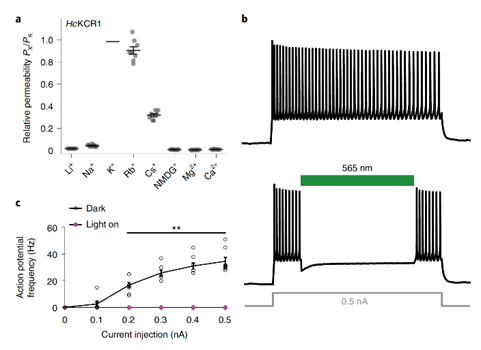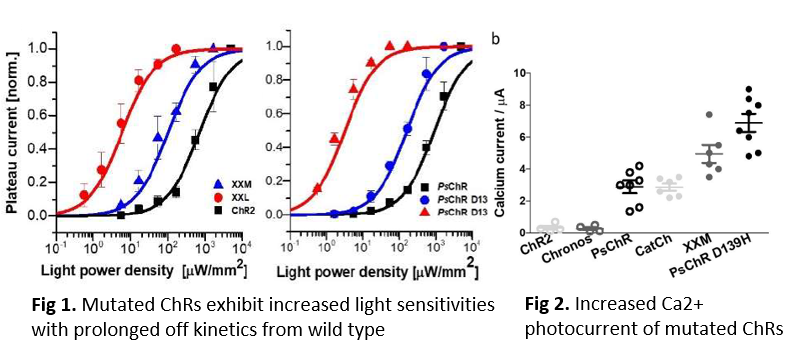Description:
When expressed in targeted neurons, light-sensitive channelrhodopsin proteins (ChRs) have the ability to selectively manipulate neuronal activity in a light-dependent manner. Kalium (potassium)-conducting channelrhodopsins (KCRs) has the potential for optogenetic applications and as therapeutic agents for electrically active cell mediated disorders, anion ChRs (ACRs) has the potential for treating excessive neuron firing in conditions such as Parkinson’s disease, neuropathic pain and epilepsy, while cation ChRs (CCRs) hold promise for vision restoration.
Dr. John Spudich and his team at UTHealth have developed suites KCRs, ACRs, and CCRs, which are orders of magnitude more efficient than currently available optogenetic tools for the potential treatment of epilepsy, Parkinson's disease, neuropathic pain, long-QT syndrome, and other cardiac arrhythmias.
Technology Overview
- Kalium ChRs (KCRs) that
- Are light-gated and have independently evolved an alternative K+ selectivity mechanism
- Are potent, highly selective of K+ over Na+, and open in less than 1 ms following photoactivation
- The permeability ratio PK/PNa of 23 makes H. catenoides KCR1 (HcKCR1) a powerful hyperpolarizing tool to suppress excitable cell firing upon illumination

Fig. KCRs is a potent optogenetic silencer of mouse cortical neurons
- Anion ChRs (ACRs) that
- Provide neuronal silencing
- Hyperpolarize cultured animal cell membranes at <1/1000 of the light intensity required by the most efficient currently available optogenetic proteins.
- Cation ChRs (CCRs) containing mutations of the transmembrane helix 4 with
- Superior photocurrent amplitudes
- Enhanced Na+ selectivity
- Enhanced Ca2+ conductance

Clinical Applications
Our ChRs have the potential to be used as gene therapy-based therapeutics for diseases caused by aberrant neuronal activity or other cellular excitation, such as epilepsy, Parkinson's disease, long-QT syndrome, and other cardiac arrhythmias.
Intellectual Property Status
Issued and pending patents (US and foreign) on suites of KCRs, ACRs, and CCRs are available for licensing:
Selected Publications
- Nat Commun. 2023 Jul 20;14(1):4365. PMID: 37474513
- Nat Neurosci. 2022 Jul; 25(7):967-974. PMID: 35726059
-
eNeuro. 2018 Jul 10;5(3). ENEURO.0174-18.2018. PMID: 30027111
-
Annu Rev Biochem. 2017 Jun 20; 86: 845–872. PMID: 28301742
-
Science. 2015 Aug 7; 349(6248):647-50. PMID: 26113638
- mBio. 2011 Jun 21; 2(3):e00115-11. PMID: 21693637
About the Investigator: Dr. John L. Spudich
- Professor of Department of Biochemistry and Molecular Biology;
- Director of Center for Membrane biology;
- Robert A. Welch Distinguished Chair in Chemistry at UTHealth
UTHealth Ref. No.: 2022-0025 (KCR), 2016-0030 (ACR), 2011-0037 (CCR)